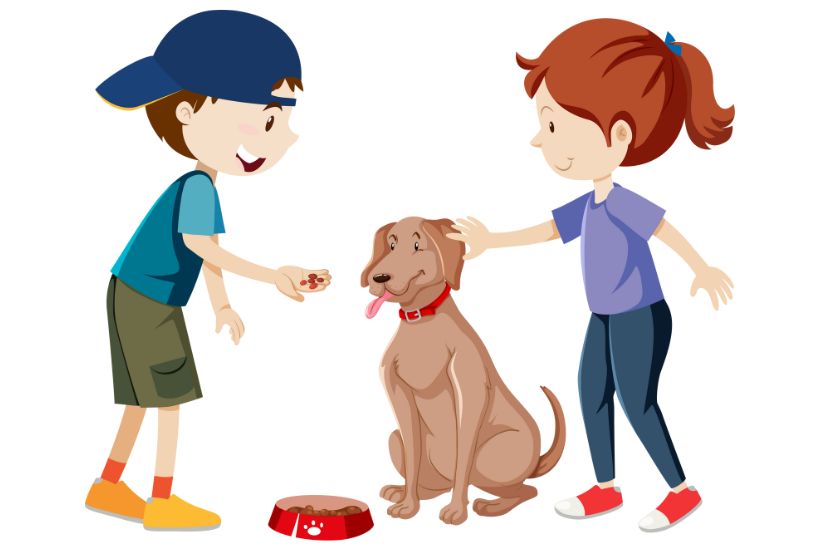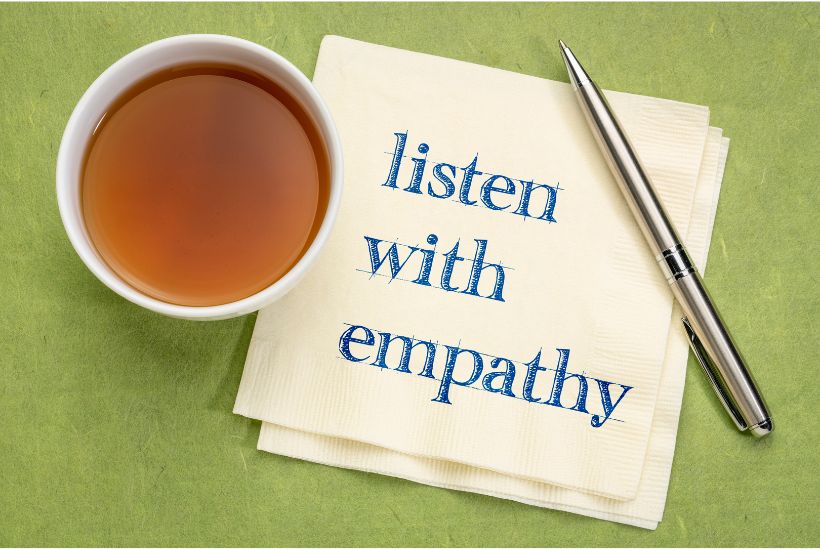What is empathy, and How does it Benefit Your Child?
Do you want your child to be successful in life? If so, teaching them empathy skills and perspective-taking skills is a must.
Perspective-taking and empathy skills are two important traits that will help them get ahead.
What is empathy, you ask?
Empathy is the ability to feel with another person and share their emotions. Both of these skills are important for children to learn to interact successfully with others.
Perspective-taking is the ability to see things from another person’s point of view and to understand their feelings.
When a child has empathy skills, they can better relate to others, which can lead to more successful relationships both professionally and personally.
In this blog post, we will discuss the importance of empathy for children and we will also provide tips on how parents can help their children develop these important skills.
So, let’s get started!

Why is perspective-taking important in childhood?
Resolving conflicts
When two people have a conflict, each person usually focuses on their own perspective and what they want.
To resolve the conflict, each person needs to understand the other person’s perspective and feelings.
This can be a difficult skill for children to learn, but it is an important one.
Empathy skills will help your child to be able to see both sides of a situation and understand how others are feeling. This can lead to more successful resolutions in conflicts, both large and small.
Prosocial behavior
Children who see things from another person’s perspective are more likely to behave helpfully and kindly.
This is because they can understand how their actions will affect others.
For example, a child who can perspective-take may be more likely to share their toys with a friend because they know that it will make their friend happy.
On the other hand, a child who cannot perspective-take may be more likely to keep their toys to themselves because they do not understand how their friend feels.
Academic success
Perspective-taking skills are also important for academic success. When children are empathetic, they can understand how another person is feeling and their needs.
This can be helpful in several situations, such as when a child is working on a group project or trying to understand a concept they are struggling with.
If a child can perspective-take, they will be better able to understand the perspective of their teacher or classmates, which can lead to improved communication and academic success.
Regulating emotions
Anger can be a normal and healthy emotion, but children must learn how to regulate their anger.
Perspective-taking skills can help with this. When children can perspective-take, they can better understand how the other person is feeling and why they might be feeling that way.
This can help to de-escalate a situation and prevent conflict.
Perspective-taking can also help children to understand their own emotions better. When children can see things from another person’s perspective, they can better understand their feelings and how they impact the people around them.
This can lead to improved self-regulation and emotional control.
Improved social skills
When children can perspective-take, they are better able to understand the perspective of others, and this can lead to improved communication and social skills.
For example, a child who can perspective-take may be more likely to start a conversation with a peer because they know that the other child is interested in the same topic.
A child who cannot perspective-take may be more likely to avoid social interaction because they do not understand how the other child is feeling.
Creativity
When children are perspective-taking, they are constantly looking at things from different angles, which can lead to increased creativity.
Perspective-taking skills help children be open-minded and think outside the box. This can lead to new and innovative ideas.
Children who are perspective-taking are also better able to understand the perspective of others, and this can lead to more successful relationships.
Empathy
As we mentioned, empathy is the ability to feel along with another person and share their emotions.
When children are empathetic, they can understand how another person feels and share in those feelings.
For example, if a child sees another child crying, they may feel empathy for that child and start crying.
Empathy is an important skill for children because it allows them to understand and respond to the emotions of others.
Stereotyping and prejudice
Perspective-taking can also help to reduce stereotyping and prejudice. When children can see things from another person’s perspective, they are less likely to make assumptions about someone based on their appearance or background.
Perspective-taking skills can help children to be more open-minded and accepting of others.
Sibling rivalry
If you have more than one child, perspective-taking can be especially important in reducing sibling rivalry.
When children can see things from their siblings’ perspectives, they can better understand their feelings and needs. This can lead to more cooperation and less conflict between siblings.
Perspective-taking skills can help your children develop a stronger bond and better understand each other.
As you can see, perspective-taking skills are important for children in many ways. Helping your child develop those skills can benefit their personal relationships, academic success, creativity, and ability to regulate their emotions.

How Early Do Kids Learn Perspective-Taking?
Perspective-taking appears to begin in middle childhood, between 6 and 7, although some researchers claim that it starts at 3 or 4 years old.
At this age, children are beginning to understand that other people have thoughts and feelings that are different from their own.
However, it is important to note that it is a complex skill that continues to develop throughout childhood and adulthood.
How can parents help their children develop perspective-taking skills?
Here are some tips for parents who want to help their children develop perspective-taking skills:
Teach your child about emotions
Teaching emotions is one of the most important things you can do to help your child develop perspective-taking skills.
When children understand emotions, they can better understand how other people are feeling. You can teach your child about emotions by reading books about feelings, talking about your own emotions, and helping them to label their own emotions.
Ask questions
You can encourage perspective-taking by asking your child questions about how someone else feels. For example, you could say, “I wonder how your friend felt when you took her toy without asking.”
- How do you think your friend felt when you took her toy without asking?
- I wonder what it’s like to be a dog. What do you think they’re thinking about right now?
- If you could switch places with anyone for a day, who would it be and why?
- Why do you think your mom is upset?
Role-playing
You can also provide opportunities for perspective-taking through different role-playing situations with your child.
For example, you could pretend to be a customer who is angry with a store clerk. You could then ask your child how they think the store clerk is feeling and what they could do to help the situation.
Model perspective-taking
Parents need to model perspective-taking for their children.
When talking to your child, try to put yourself in their shoes and see things from their perspective. This will help your child see that perspective-taking is something adults do too.
Encourage creativity
Creativity encourages perspective-taking because it requires children to think about things differently.
You can encourage creativity by providing opportunities for your child to be creative, such as painting, drawing, building with blocks, and playing make-believe.
Read stories together
Stories are a great way to help children understand perspective-taking. Look for stories that contain characters with different perspectives, such as The Lion and the Mouse or The Ant and the Grasshopper.
As you read the story, discuss how the different characters feel and why they may feel that way.
Encourage perspective-taking in everyday situations.
There are many opportunities for perspective-taking in everyday life.
For example, you could ask your child how they think the cashier at the grocery store is feeling. You could also encourage your child to think about how a book or TV show character feels.
Whenever you see an opportunity for perspective-taking, take a few minutes to discuss it with your child.
Words Matter
The words you use can also encourage perspective-taking.
For example, instead of saying “be good,” say “be kind.” Instead of saying, “don’t hit your sister,” say, “we use gentle hands.”
Using words that focus on other people’s feelings helps your child to think about how their actions affect others.

Examples of perspective-taking
- Offering to share your toys with a friend
- Helping someone who is lost find their way
- Thinking about how a character in a book or TV show is feeling
- Asking your child how they think the cashier at the grocery store is feeling
- Thinking about the best way to help sick people
- Giving someone the benefit of the doubt
- Offering to help someone with a task
- Sharing your favorite food or drink with a friend
- Putting yourself in another person’s shoes
- Asking questions to gain perspective about a situation
- Showing interest in other people’s lives and experiences
- Volunteering for a good cause
- Listening to someone’s perspective, even if you disagree with it
Children’s book about empathy
The Rabbit Listened
By Cory Silverberg is a great children’s book about empathy. This book is about a rabbit who listens to his friends after they all experience something bad. The rabbit doesn’t try to fix their problems; he just listens and helps them feel better.
This book is a great way to show your child that sometimes the best thing you can do for someone is just listen.
The Invisible Boy
By Trudy Ludwig is another great book about empathy. This book is about a boy who is invisible to everyone at school, until one day a new boy comes, and they both help each other feel seen and understood. It’s a beautiful story about perspective-taking and friendship.
This book is a great way to show your child that everyone has value and that it’s important to see people for who they are.
Be Kind
By Pat Zietlow Miller is a great book about perspective-taking and empathy. This book is about the meaning of kindness and the story of a girl who is thinking about how to help her classmate. The book goes through different acts of kindness that the girl does and how they make her feel.
This book is a great way to show your child that perspective-taking and empathy can be rewarding.
We’re All Wonders
By R. J. Palacio is a great book about perspective-taking and empathy. This book is about a boy with facial differences who goes to school for the first time. The book follows his struggles and how he learns to see things from other people’s perspectives.
This book is a great way to show your child that perspective-taking can be difficult, but it’s worth it.
Games that help with perspective-taking
Some great games can help your child with perspective-taking.
One of my favorites is “I Spy.” In this game, one person looks for something, and the other has to guess what it is. This game helps with perspective taking because the person guessing has to think about what the other person is seeing.
Other great games that help with perspective-taking include “Charades,” “20 Questions,” and “Simon Says.”
These games are all great ways to help your child practice perspective-taking.
Parenting tip
One parenting tip I have is to try to catch your child being perspective-taking. When you see them doing something kind or helpful, point it out and praise them. This will help them to see that perspective-taking is important and valued.
Another parenting tip is to provide opportunities for your child. You can do this by asking them questions about how someone might be feeling in a given situation. For example, “How do you think the cashier feels when people are rude to her?” or “How would you feel if your best friend moved away?”
Final Thoughts
Perspective-taking is an important skill for children to learn. It helps them understand how other people are feeling and why they may feel that way. Perspective-taking also leads to empathy and compassion.
There are many ways you can encourage empathy in your child. For example, you can read stories together, talk about how words matter, and provide opportunities for your child to be creative. You can also encourage empathy in everyday situations.
What are some of the ways you encourage empathy in your child? Let us know in the comments below.
If you liked this post, please share it! Thank you!






